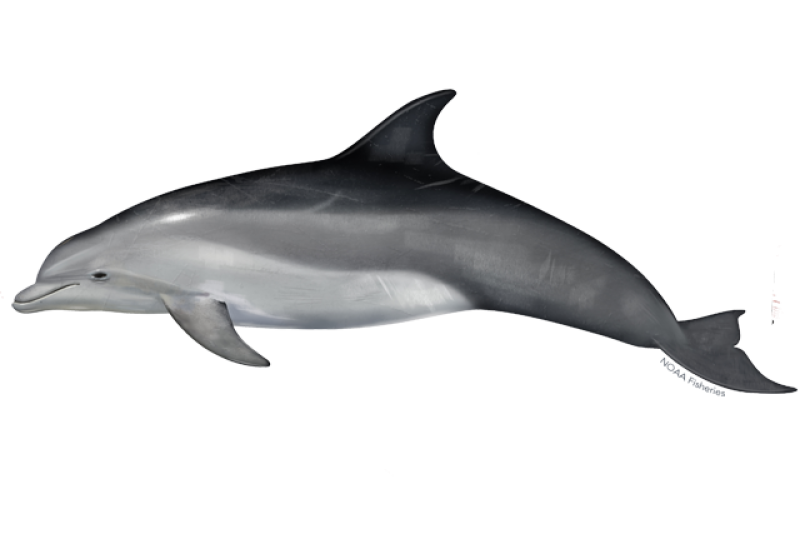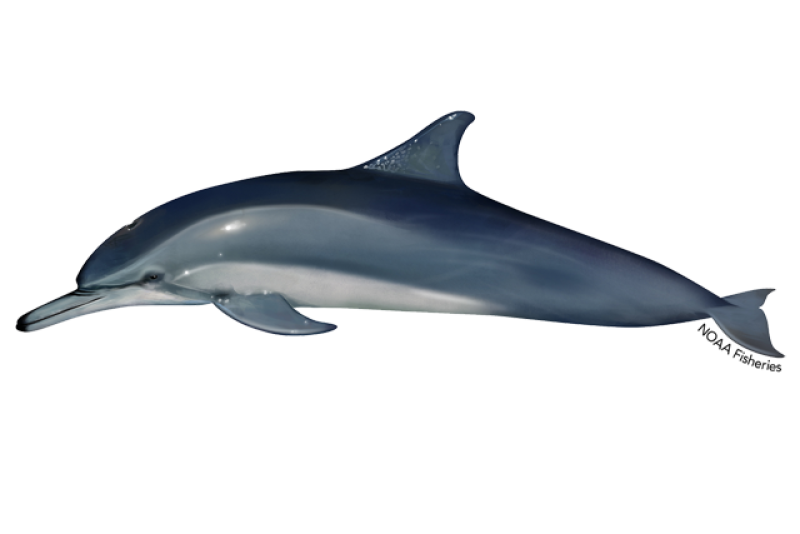Short-Beaked Common Dolphin
Delphinus delphis

Protected Status
Quick Facts
 Short-beaked dolphin. Credit: NOAA Fisheries
Short-beaked dolphin. Credit: NOAA Fisheries
Short-beaked dolphin. Credit: NOAA Fisheries
About the Species
 Short-beaked dolphin. Credit: NOAA Fisheries
Short-beaked dolphin. Credit: NOAA Fisheries
Short-beaked dolphin. Credit: NOAA Fisheries
Short-beaked common dolphins are one of the most abundant and familiar dolphins in the world. This highly social and energetic species is widely distributed in sub-tropical to temperate waters. Short-beaked common dolphins are often found in association with underwater ridges, seamounts, and continental shelves where upwelling (a process in which deep, cold, nutrient-rich water rises toward the surface) occurs and prey is abundant.
Short-beaked common dolphins are closely related to—and easily confused with—long-beaked common dolphins. Once thought to be a single species, the two species differ slightly in size, appearance, and habitat preference.
Short-beaked common dolphins in the United States are not endangered or threatened. Like all marine mammals, they are protected under the Marine Mammal Protection Act (MMPA).
Population Status
NOAA Fisheries estimates population size for each stock of short-beaked common dolphin in its stock assessment reports. Overall, this species is still abundant worldwide, except for a few specific populations. There is insufficient data for this species to determine population trends.
Appearance
Short-beaked common dolphins range from 6 to 8 feet long and weigh, on average, 170 pounds. Adult males are slightly larger than females. They have a rounded forehead (known as a melon), a moderately long rostrum, and 40 to 57 pairs of small, sharp teeth in each jaw. Their bodies are sleek with a relatively tall, triangular dorsal fin in the middle of their back.
Short-beaked common dolphins can be identified by their distinctive color pattern, which is often referred to as an “hourglass pattern.” A dark gray cape extends along the back from the head to just below the dorsal fin where a "V" is visible on either side of the body, creating an hourglass image. Forward of the dorsal fin, behind the head, is a yellow/tan panel that contrasts with the dark cape on their back. The side of the body behind the dorsal fin is light gray, and narrow. A dark stripe extends from the lower jaw to the flipper, which includes a complex facial color pattern. The eye is not typically within the stripe, but still stands out due to a patch of dark pigment around the eye.
The color patterns of young and juvenile short-beaked common dolphins are somewhat more muted and paler than older, adult dolphins. Considerable variation in color patterns are evident within populations but more markedly different coloration patterns are evident in other geographic areas.
Behavior and Diet
Short-beaked common dolphins are usually found in large social groups averaging hundreds of individuals and are occasionally seen in larger groups—known as mega-pods—consisting of thousands of animals (up to 10,000 individuals). These large groups are thought to consist of sub-groups of 20 to 30 individuals that are possibly related or separated by age and/or sex.
Short-beaked common dolphins are often active at the surface. These highly social and energetic dolphins commonly leap out of the water at high speeds, flip end-over-end, and somersault in the air. They may also swim alongside ships riding the bow for long periods of time. This “bow riding” behavior has also been observed alongside large whales.
Short-beaked common dolphins usually rest during the day and feed at night. They can dive to approximately 1,000 feet but typically dive to about 100 feet to feed on schooling fish and cephalopods (e.g., squid) that migrate towards the surface at night. Short-beaked common dolphins associate with schools of tuna and seabird-feeding flocks, especially in the eastern tropical Pacific Ocean. They have also been observed in mixed groups with spinner dolphins and striped dolphins.
Where They Live
Short-beaked common dolphins prefer sub-tropical to temperate waters that are primarily offshore. They can be found along the continental slope in waters between approximately 300 to 6,500 feet deep. In the western North Atlantic, they are often associated with the Gulf Stream current. Short-beaked common dolphins are often associated with underwater geologic features such as underwater ridges and seamounts where upwelling occurs, increasing nutrient concentrations and supporting higher productivity. The abundance and distribution of short-beaked common dolphins vary based on interannual changes, oceanographic conditions, and seasons. They can be found on the continental shelf or farther offshore. On the U.S. west coast, these dolphins are primarily associated with the California Current and are abundant off California year-round from nearshore to about 300 miles offshore. On the U.S. east coast, they are more common north of Cape Hatteras, North Carolina. From summer through autumn, large aggregations of short-beaked common dolphins can be found near Georges Bank (extending from Cape Cod, Massachusetts, to Nova Scotia, Canada), Newfoundland, and the Scotian Shelf. Other distinct populations can be found off of northern Europe, Newfoundland, Africa, Japan, southern Australia, New Zealand, the Black Sea, the Mediterranean Sea, and the southwestern Pacific.
Lifespan & Reproduction
Short-beaked common dolphins have an estimated lifespan of up to 35 years. On average, males become sexually mature at 10 years and females at 8 years, although individuals may become sexually mature between 5 and 12 years. Off the California coast, calving takes place during the winter months after a 10- to 11-month gestation period, whereas calving takes place year-round in the eastern tropical Pacific Ocean. Every 2 to 3 years, adult females give birth to a single calf that is about 2.5 to 3 feet long. Calves begin to wean after about 1 year, but remain dependent on their mother for an additional year or more.
Threats
Entanglement in Fishing Gear
One of the main threats to short-beaked common dolphins is getting caught in fishing gear. They can become entangled in commercial fishing gear such as gillnets, seines, trawls, trap pots, and longlines. In many fisheries in the Atlantic Ocean, short-beaked common dolphins are caught as bycatch, and they have the highest mortality rate of all cetaceans affected by the drift gillnet fishery operating off the coast of California.
Hunting
Russia, Japan, and nations bordering the Black Sea and the Mediterranean Sea, hunt short-beaked common dolphins for their meat and oil.
Scientific Classification
| Kingdom | Animalia | Phylum | Chordata | Class | Mammalia | Order | Cetacea | Family | Delphinidae | Genus | Delphinus | Species | delphis |
|---|
Last updated by NOAA Fisheries on 03/06/2025
What We Do
Conservation & Management
All short-beaked common dolphins are protected under the Marine Mammal Protection Act. Our work protects short-beaked common dolphins by:
- Reducing interactions with commercial and recreational fishing gear
- Minimizing harassment and illegal feeding
- Responding to dead, injured, or entangled dolphins
- Encouraging responsible viewing of wild dolphins
- Minimizing the effects of vessel disturbance, noise, and other types of human impacts
Science
Our research projects have helped us better understand short-beaked common dolphins and the challenges they face. Our work includes:
- Undertaking stock assessments to determine the status of populations and/or sub-populations
- Investigating strandings
- Examining population structure, abundance, and dynamics using a variety of research techniques, including ecosystem surveys and genetics
How You Can Help
Keep Your Distance
Be responsible when viewing marine life in the wild. Observe all dolphins and porpoises from a safe distance of at least 50 yards and limit your time spent observing to 30 minutes or less.
Report Marine Life in Distress
Report a sick, injured, entangled, stranded, or dead animal to make sure professional responders and scientists know about it and can take appropriate action. Numerous organizations around the country are trained and ready to respond. Never approach or try to save an injured or entangled animal yourself—it can be dangerous to both the animal and you.
Learn who you should contact when you encounter a stranded or injured marine animal
Don't Feed Wild Dolphins
Dolphins fed by humans lose their natural wariness and learn to associate people with food, causing them to beg for handouts and take bait and catch directly from fishing gear. This puts them at risk from vessel strikes and becoming entangled in or ingesting fishing gear. Dolphins may teach these behaviors to their young, thereby putting them at risk.
More on protecting wild dolphins and admiring them from a distance
Report a Violation
Call the NOAA Fisheries Enforcement Hotline at (800) 853-1964 to report a federal marine resource violation. This hotline is available 24 hours a day, 7 days a week for anyone in the United States.
You may also contact your closest NOAA Office of Law Enforcement field office during regular business hours.
Featured News
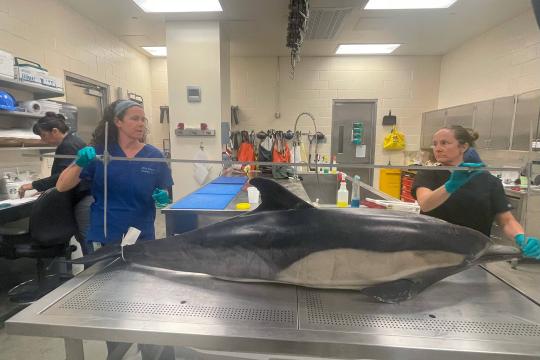 Scientists at NOAA Fisheries' Southwest Fisheries Science Center measure the carcass of a short-beaked common dolphin that stranded near San Diego during the ongoing domoic acid event. They will also collect additional information and samples to assess the dolphin's condition. Credit: Southwest Fisheries Science Center.
Scientists at NOAA Fisheries' Southwest Fisheries Science Center measure the carcass of a short-beaked common dolphin that stranded near San Diego during the ongoing domoic acid event. They will also collect additional information and samples to assess the dolphin's condition. Credit: Southwest Fisheries Science Center.
Stranding Team Responds to More Than a Dozen Dead or Dying San Diego Dolphins in a Single Day
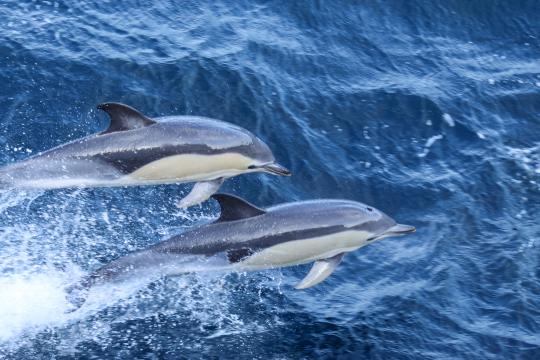 Common dolphins. Credit: NOAA Fisheries/Michelle Klein
Common dolphins. Credit: NOAA Fisheries/Michelle Klein
Celebrating 15 Years of Surveying Protected Species in the Northwest Atlantic
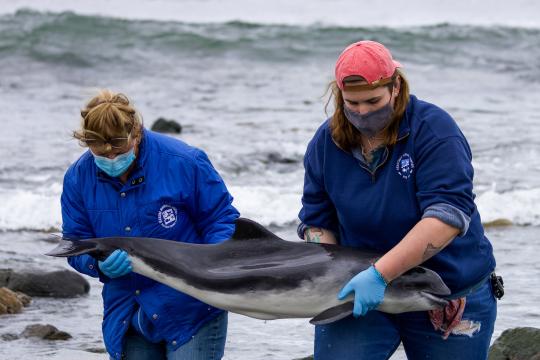 A harbor porpoise is retrieved from the rocks at Odiorne Point State Park, New Hampshire. Credit: Seacoast Science Center
A harbor porpoise is retrieved from the rocks at Odiorne Point State Park, New Hampshire. Credit: Seacoast Science Center
2020 and 2021 Combined Report of Marine Mammal Strandings in the United States
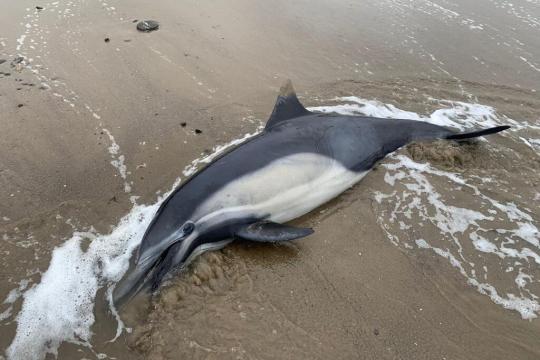 Deceased dolphin as a result of domoic acid poisoning. Credit: Channel Islands Marine & Wildlife Institute
Deceased dolphin as a result of domoic acid poisoning. Credit: Channel Islands Marine & Wildlife Institute
Toxic Algal Bloom Suspected in Dolphin and Sea Lion Deaths in Southern California
Management Overview
The short-beaked common dolphin is protected throughout its range under the Marine Mammal Protection Act.
Additionally, the short-beaked common dolphin is listed under:
- Appendix II of the Convention on International Trade in Endangered Species of Wild Fauna and Flora (CITES)
- Annex II of the Protocol for Specially Protected Areas and Wildlife (SPAW)

Conservation Efforts
Dolphin-Safe/Tuna Tracking and Verification Program
Dolphins, like other marine mammals, may become bycatch in fisheries. Some species of tuna are known to aggregate beneath schools of certain dolphin stocks. In some parts of the world, this close association led to the fishing practice of encircling a dolphin school to capture the tuna concentrated below, to the detriment of the dolphins, which would get trapped in the net. The Dolphin Protection Consumer Information Act established a national tuna tracking program to ensure that tuna imported into the United States meets certain requirements to ensure the safety of dolphins during tuna fishing operations.
Learn more about the Dolphin-Safe/Tuna Tracking and Verification Program
Reducing Interactions with Fishing Gear
Short-beaked common dolphins are caught as bycatch in fishing gear, leading to serious injuries or death. NOAA Fisheries works with fishermen, industry, non-government organizations, and academia to find approaches and strategies for reducing bycatch in U.S. fisheries.
Learn more about bycatch and fisheries interactions
Overseeing Marine Mammal Health and Stranding Response
We work with volunteer networks in all coastal states to respond to marine mammal strandings including all dolphins and porpoises. When stranded animals are found alive, NOAA Fisheries and our partners assess the animal’s health and determine the best course of action. When stranded animals are found dead, our scientists work to understand and investigate the cause of death. Although the cause often remains unknown, scientists can sometimes attribute strandings to disease, harmful algal blooms, vessel strikes, fishing gear entanglements, pollution exposure, and underwater noise. Some strandings can serve as indicators of ocean health, giving insight into larger environmental issues that may also have implications for human health and welfare.
Learn more about the Marine Mammal Health and Stranding Response Program
Marine Mammal Unusual Mortality Events
Short-beaked common dolphins have been part of a declared unusual mortality event in the past. Under the Marine Mammal Protection Act, an unusual mortality event is defined as "a stranding that is unexpected; involves a significant die-off of any marine mammal population; and demands immediate response." To understand the health of marine mammal populations, scientists study unusual mortality events.
Get information on active and past UMEs
Get an overview of marine mammal UMEs
Minimizing Harassment and Illegal Feeding
As human interactions with wild dolphins increase, so does the risk of disturbing or injuring these animals. NOAA Fisheries provides guidance on how to safely and responsibly view dolphins, including the following initiatives:
Learn more about the rules regarding feeding and harassing marine mammals in the wild
Regulatory History
Short-beaked common dolphins are protected under the Marine Mammal Protection Act (MMPA).
In 1999, the United States signed on as a Party to the Agreement on the International Dolphin Conservation Program (AIDCP) (PDF, 23 pages). In addition to other requirements, the AIDCP mandates the establishment of an international tuna tracking program for tuna caught in the eastern tropical Pacific Ocean. The program helps minimize dolphin deaths during fishing for tuna destined for canning.
The International Dolphin Conservation Program Act (PDF, 19 pages) amended the MMPA to make the objectives and requirements of the AIDCP legally effective in the United States.
Key Actions and Documents
Last updated by NOAA Fisheries on 03/06/2025
Science Overview
Stock Assessments
Estimating the size of short-beaked common dolphin populations and the number of dolphins incidentally killed in fisheries helps resource managers determine the success of NOAA Fisheries conservation measures. Our scientists collect and present these data in annual stock assessment reports.

Collecting Data on Strandings
To understand the health of dolphin populations, scientists work with our stranding network partners to collect data on all marine mammal strandings. Scientists study strandings such as the 2012 mass stranding of short-beaked common dolphins on Cape Cod, Massachusetts, in which 107 dolphins stranded dead, and another 71 stranded alive. Data from strandings has also contributed to understanding the impact of domoic acid on short-beaked common dolphins, to identify diseases affecting their populations and to identify additional mortality caused by fisheries without observer programs.
Shipboard Studies
NOAA Fisheries conducts research cruises to collect information on short-beaked common dolphins’ habitat preferences and feeding ecology. For example, in 2009, NOAA’s Southwest Fisheries Science Center conducted a research cruise to help estimate the abundance of both long-beaked and short-beaked common dolphins off southern California in the United States and Baja California in Mexico. For both species, NOAA collected data to estimate abundance, pregnancy and birth rates, reproduction timing, gene flow, and contaminant concentrations. NOAA also characterized the habitat and ecosystem in which these dolphins live. NOAA Fisheries can use information from this research to improve conservation and management plans for these species.
Last updated by NOAA Fisheries on 03/06/2025
Research
Marine Mammal Life History
Data collected from stranded and bycaught marine mammals are critical to understanding their life history
Cetacean Health & Life History Program
Assessing the health of whales and dolphins within a life-history perspective
Outreach & Education
Dolphin Friendly Fishing Tips Sign
This sign is often posted near boat ramps, piers, docks, marinas, and waterfront parks.
Protect Wild Dolphins Sign
This sign is often posted near boat ramps, piers, docks, marinas, and waterfront parks.
Don't Feed Wild Dolphin Sign
This sign is often posted near boat ramps, piers, docks, marinas, and waterfront parks.
Last updated by NOAA Fisheries on 03/06/2025

